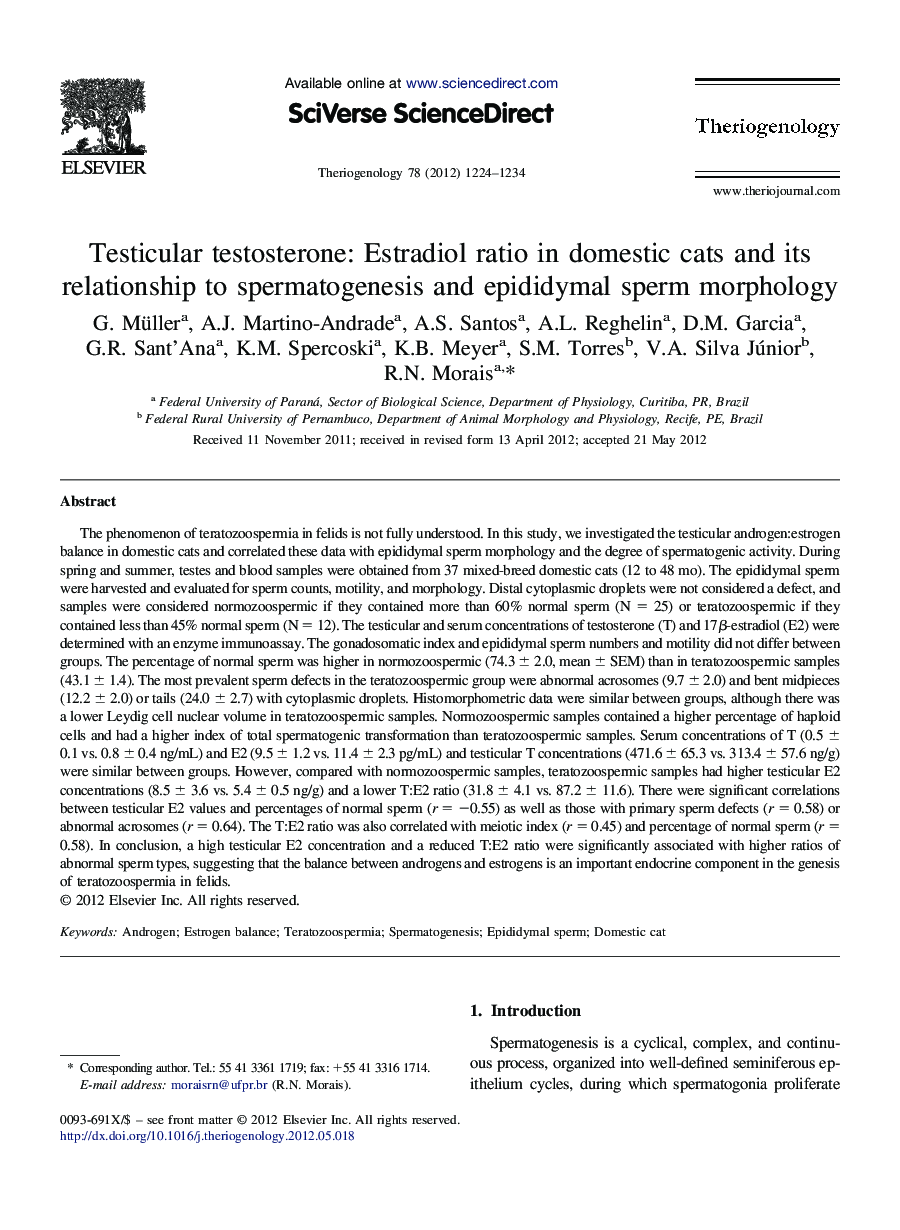| کد مقاله | کد نشریه | سال انتشار | مقاله انگلیسی | نسخه تمام متن |
|---|---|---|---|---|
| 10892363 | 1082100 | 2012 | 11 صفحه PDF | دانلود رایگان |
عنوان انگلیسی مقاله ISI
Testicular testosterone: Estradiol ratio in domestic cats and its relationship to spermatogenesis and epididymal sperm morphology
دانلود مقاله + سفارش ترجمه
دانلود مقاله ISI انگلیسی
رایگان برای ایرانیان
کلمات کلیدی
موضوعات مرتبط
علوم زیستی و بیوفناوری
علوم کشاورزی و بیولوژیک
علوم دامی و جانورشناسی
پیش نمایش صفحه اول مقاله

چکیده انگلیسی
The phenomenon of teratozoospermia in felids is not fully understood. In this study, we investigated the testicular androgen:estrogen balance in domestic cats and correlated these data with epididymal sperm morphology and the degree of spermatogenic activity. During spring and summer, testes and blood samples were obtained from 37 mixed-breed domestic cats (12 to 48 mo). The epididymal sperm were harvested and evaluated for sperm counts, motility, and morphology. Distal cytoplasmic droplets were not considered a defect, and samples were considered normozoospermic if they contained more than 60% normal sperm (N = 25) or teratozoospermic if they contained less than 45% normal sperm (N = 12). The testicular and serum concentrations of testosterone (T) and 17β-estradiol (E2) were determined with an enzyme immunoassay. The gonadosomatic index and epididymal sperm numbers and motility did not differ between groups. The percentage of normal sperm was higher in normozoospermic (74.3 ± 2.0, mean ± SEM) than in teratozoospermic samples (43.1 ± 1.4). The most prevalent sperm defects in the teratozoospermic group were abnormal acrosomes (9.7 ± 2.0) and bent midpieces (12.2 ± 2.0) or tails (24.0 ± 2.7) with cytoplasmic droplets. Histomorphometric data were similar between groups, although there was a lower Leydig cell nuclear volume in teratozoospermic samples. Normozoospermic samples contained a higher percentage of haploid cells and had a higher index of total spermatogenic transformation than teratozoospermic samples. Serum concentrations of T (0.5 ± 0.1 vs. 0.8 ± 0.4 ng/mL) and E2 (9.5 ± 1.2 vs. 11.4 ± 2.3 pg/mL) and testicular T concentrations (471.6 ± 65.3 vs. 313.4 ± 57.6 ng/g) were similar between groups. However, compared with normozoospermic samples, teratozoospermic samples had higher testicular E2 concentrations (8.5 ± 3.6 vs. 5.4 ± 0.5 ng/g) and a lower T:E2 ratio (31.8 ± 4.1 vs. 87.2 ± 11.6). There were significant correlations between testicular E2 values and percentages of normal sperm (r = â0.55) as well as those with primary sperm defects (r = 0.58) or abnormal acrosomes (r = 0.64). The T:E2 ratio was also correlated with meiotic index (r = 0.45) and percentage of normal sperm (r = 0.58). In conclusion, a high testicular E2 concentration and a reduced T:E2 ratio were significantly associated with higher ratios of abnormal sperm types, suggesting that the balance between androgens and estrogens is an important endocrine component in the genesis of teratozoospermia in felids.
ناشر
Database: Elsevier - ScienceDirect (ساینس دایرکت)
Journal: Theriogenology - Volume 78, Issue 6, 1 October 2012, Pages 1224-1234
Journal: Theriogenology - Volume 78, Issue 6, 1 October 2012, Pages 1224-1234
نویسندگان
G. Müller, A.J. Martino-Andrade, A.S. Santos, A.L. Reghelin, D.M. Garcia, G.R. Sant'Ana, K.M. Spercoski, K.B. Meyer, S.M. Torres, V.A. Silva Júnior, R.N. Morais,